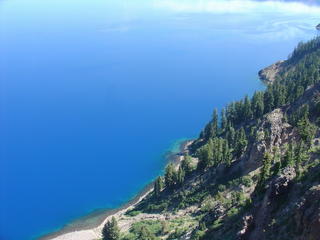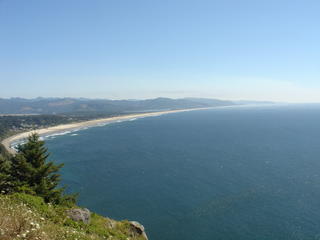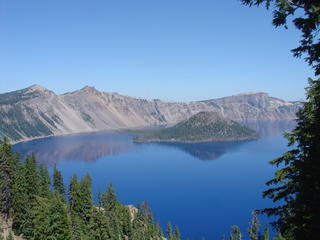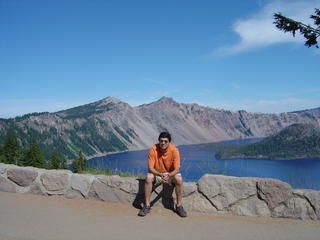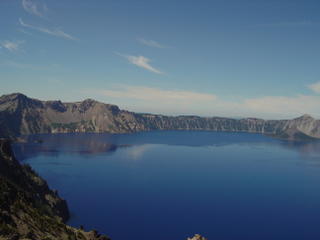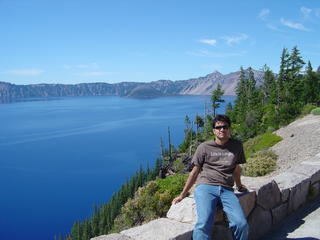If you could be born again
where would you want to live?
well, I would like to live
where there may be sunshine
blue skies, stars at night and dreams
and there must be you that I love
well there might not be
sunshine and blue skies and
stars at night and dreams
where I live
but there must be you that I love
because you are the one for whom I live.
Wednesday, August 31, 2005
Wednesday, August 24, 2005
Crater Lake (1 of 3)
Finally I am blogging after a break of about 2 weeks. This weekend we (my brother and I) went to Crater Lake. Crater Lake is about 700 miles south of Seattle. We decided that instead of taking the shorter route along an interstate (highway) we will drive along the Pacific Coast Highway. The Pacific Coast Highway runs along the western coastline of the US from Washington (Olympic Peninsula) all the way down to California. We started Saturday morning and took our first break at Canon beach. Nestled between the Pacific Ocean and the Coast Mountain Range, Cannon Beach; is famed for its forested headlands, towering monoliths and miles of pristine, sandy beaches. Continuing south from Canon beach, our next stop was at Tillamook. Tillamook is the home of Tillamook cheese (a local brand which is quite good). So how can a visit to the home of a cheese company be complete without a visit to the cheese factory? It was really exciting to see the cheese being made (It was somewhat like the Aarey Milk Colony factory). With our stomachs full we made out way towards Crater Lake.
Crater Lake is located in southern Oregon on the crest of the Cascade Range, 100 miles (160 km) east of the Pacific Ocean. It lies inside a caldera, or volcanic basin, created when the 12,000 foot (3,660 meter) high Mount Mazama collapsed 7,700 years ago after a large eruption. The lake is approximately 5 miles (8 km) wide, and is surrounded by steep rock walls that rise up to 2,000 feet (600 meters) above the lake's surface. Following the collapse of Mount Mazama, lava poured into the caldera at several places even as the lake began to rise. These flows created underwater features as well as Wizard Island, a cinder cone that rises 764 feet (233 meters) above the lake and is surrounded by black volcanic lava blocks.
The dramatic color of Crater Lake is the product of its great depth, the purity and clarity of its water, and the way light interacts with water. Water molecules absorb the longer wavelengths of light better (reds, oranges, yellows, and greens). Shorter wavelengths (blues) are more easily scattered than absorbed. In the deep lake, some of the scattered blue light is redirected back up to the surface where we can see it. Around the edges where the water is less deep, some of the unabsorbed green light is reflected back up, too. Although the color of the lake can vary from day to day depending on wind, cloud cover, and the angle of the sun, the different shades of blue are always spectacular.
Since the lake is filled almost entirely by snowfall, it is incredibly pure. Sunlight is able to penetrate the waters of Crater Lake to great depths. Researchers using an instrument called a "Secchi disk" can easily determine lake clarity. They simply lower the 8-inch black and white disk into the water, and measure the depth at which the disk is no longer visible from the surface. For most lakes, readings deeper than 100 feet (30 meters) are rare, but Crater Lake holds a world record clarity reading of 142 feet (43.3 meters)!
We took a boat ride in the lake. The boat ride is offered by the National Park Service and is a two hour tour along the circumference of the lake. One has to climb down about 750 feet to reach the only accessible part of the lake. The water was extremely clear and had a dark shade of blue. I had never seen something like this before. In the evening we camped at the Mazama campgrounds. There was a ranger show that night which included a slide show of the mountain and information about the flora anf fauna on the mountain.
Park forests are composed mostly of conifers, although a few hardwood species can be found. Starting in the park’s lower elevations (about 4,500 feet or 1,370 meters), ponderosa pine forest is the first zone seen. The ponderosa zone gives way to lodgepole pine forest at about 5,000 feet (1,520 meters). Sometimes referred to as “dog’s hair forest” because of the dense, scraggly stands of thin lodgepoles, this zone covers vast areas. Mountain hemlocks become dominant at about 6,000 feet (1,830 meters). This zone has the final tall trees in the park and has limited underbrush. The next zone is almost purely whitebark pines and extends from about 7,500 feet (2,290 meters) to the top of Mt. Scott, the highest point in the park (8,929 feet or 2,721 meters). The whitebark pine zone is more an open woodland than a forest.
One thing is for sure, Crater Lake ranks amongst the most beautiful places I have ever seen.
Crater Lake is located in southern Oregon on the crest of the Cascade Range, 100 miles (160 km) east of the Pacific Ocean. It lies inside a caldera, or volcanic basin, created when the 12,000 foot (3,660 meter) high Mount Mazama collapsed 7,700 years ago after a large eruption. The lake is approximately 5 miles (8 km) wide, and is surrounded by steep rock walls that rise up to 2,000 feet (600 meters) above the lake's surface. Following the collapse of Mount Mazama, lava poured into the caldera at several places even as the lake began to rise. These flows created underwater features as well as Wizard Island, a cinder cone that rises 764 feet (233 meters) above the lake and is surrounded by black volcanic lava blocks.
The dramatic color of Crater Lake is the product of its great depth, the purity and clarity of its water, and the way light interacts with water. Water molecules absorb the longer wavelengths of light better (reds, oranges, yellows, and greens). Shorter wavelengths (blues) are more easily scattered than absorbed. In the deep lake, some of the scattered blue light is redirected back up to the surface where we can see it. Around the edges where the water is less deep, some of the unabsorbed green light is reflected back up, too. Although the color of the lake can vary from day to day depending on wind, cloud cover, and the angle of the sun, the different shades of blue are always spectacular.
Since the lake is filled almost entirely by snowfall, it is incredibly pure. Sunlight is able to penetrate the waters of Crater Lake to great depths. Researchers using an instrument called a "Secchi disk" can easily determine lake clarity. They simply lower the 8-inch black and white disk into the water, and measure the depth at which the disk is no longer visible from the surface. For most lakes, readings deeper than 100 feet (30 meters) are rare, but Crater Lake holds a world record clarity reading of 142 feet (43.3 meters)!
We took a boat ride in the lake. The boat ride is offered by the National Park Service and is a two hour tour along the circumference of the lake. One has to climb down about 750 feet to reach the only accessible part of the lake. The water was extremely clear and had a dark shade of blue. I had never seen something like this before. In the evening we camped at the Mazama campgrounds. There was a ranger show that night which included a slide show of the mountain and information about the flora anf fauna on the mountain.
Park forests are composed mostly of conifers, although a few hardwood species can be found. Starting in the park’s lower elevations (about 4,500 feet or 1,370 meters), ponderosa pine forest is the first zone seen. The ponderosa zone gives way to lodgepole pine forest at about 5,000 feet (1,520 meters). Sometimes referred to as “dog’s hair forest” because of the dense, scraggly stands of thin lodgepoles, this zone covers vast areas. Mountain hemlocks become dominant at about 6,000 feet (1,830 meters). This zone has the final tall trees in the park and has limited underbrush. The next zone is almost purely whitebark pines and extends from about 7,500 feet (2,290 meters) to the top of Mt. Scott, the highest point in the park (8,929 feet or 2,721 meters). The whitebark pine zone is more an open woodland than a forest.
One thing is for sure, Crater Lake ranks amongst the most beautiful places I have ever seen.
Friday, August 05, 2005
Dark Matter Axions
For each of the stellar, galactic, and galaxy cluster/super cluster observations the basic principle is that if we measure velocities in some region, then there has to be enough mass there for gravity to stop all the objects flying apart. When such velocity measurements are done on large scales, it turns out that the amount of inferred mass is much more than can be explained by the luminous stuff. Hence we infer that there is dark matter in the Universe. Dark matter (DM) candidates are usually split into two broad categories, Baryonic and Non-Baryonic with the second category being further sub-divided into (HDM) hot dark matter and cold dark matter (CDM) depending on their respective masses and speeds. CDM candidates travel at slow speeds (hence "cold") or have little pressure, while HDM candidates move rapidly (hence "hot").
Astrophysical observations increasingly suggest there's a large amount of cold dark matter in the universe, and the axion, a hypothetical elementary particle, is a compelling dark-matter candidate. Dark-matter axions normally have only feeble couplings to matter and radiation, but a RF cavity threaded by a magnetic field causes a few nearby halo axions to convert into microwave photons. These photons can then be detected with an exquisitely sensitive receiver, and several groups around the world search in this way for Milky Way halo axions at the upper end of their expected coupling range.
The research group at Lawrence Livermore National Laboratory launched a high-sensitivity upgrade that exploits advances in low-noise quantum electronics. These upgraded receivers are by far the world's most sensitive to microwave radiation, having noise near the quantum limit. This upgraded experiment will be definitive, capable of detecting or ruling out the entire range of plausible dark-matter axion masses and couplings.
Summary of talk by Leslie Rosenberg at the University of Washington science colloquium.
Astrophysical observations increasingly suggest there's a large amount of cold dark matter in the universe, and the axion, a hypothetical elementary particle, is a compelling dark-matter candidate. Dark-matter axions normally have only feeble couplings to matter and radiation, but a RF cavity threaded by a magnetic field causes a few nearby halo axions to convert into microwave photons. These photons can then be detected with an exquisitely sensitive receiver, and several groups around the world search in this way for Milky Way halo axions at the upper end of their expected coupling range.
The research group at Lawrence Livermore National Laboratory launched a high-sensitivity upgrade that exploits advances in low-noise quantum electronics. These upgraded receivers are by far the world's most sensitive to microwave radiation, having noise near the quantum limit. This upgraded experiment will be definitive, capable of detecting or ruling out the entire range of plausible dark-matter axion masses and couplings.
Summary of talk by Leslie Rosenberg at the University of Washington science colloquium.
Thursday, August 04, 2005
Sarkar
 One of the best movies I have seen so far...........amazing.....at last a hindi movie with no songs (the movie did not warrant any songs but with hindi movies ...) and Abhishek Bachan is simply superb. I was a bit apprehensive before watching the movie as may people had told me it is a copy of "Godfather"..with a bit of Mumbai politics. But Ram Gopal Verma has really done a great job..... fantastic....The best dialouge for me was in the end when Abhishek tells the CM "Main bhi to vohi cahata hoon"......
One of the best movies I have seen so far...........amazing.....at last a hindi movie with no songs (the movie did not warrant any songs but with hindi movies ...) and Abhishek Bachan is simply superb. I was a bit apprehensive before watching the movie as may people had told me it is a copy of "Godfather"..with a bit of Mumbai politics. But Ram Gopal Verma has really done a great job..... fantastic....The best dialouge for me was in the end when Abhishek tells the CM "Main bhi to vohi cahata hoon"......A good hindi move after a long time with excellent performances by all.
Subscribe to:
Posts (Atom)
